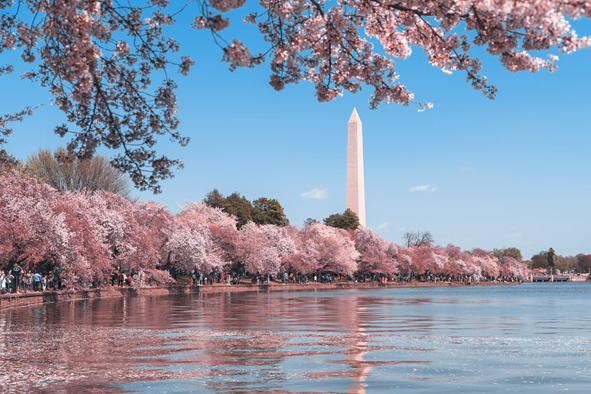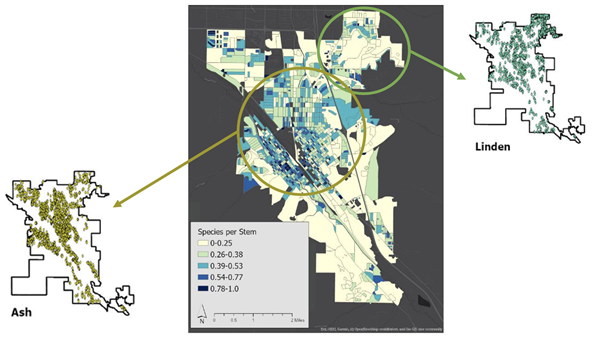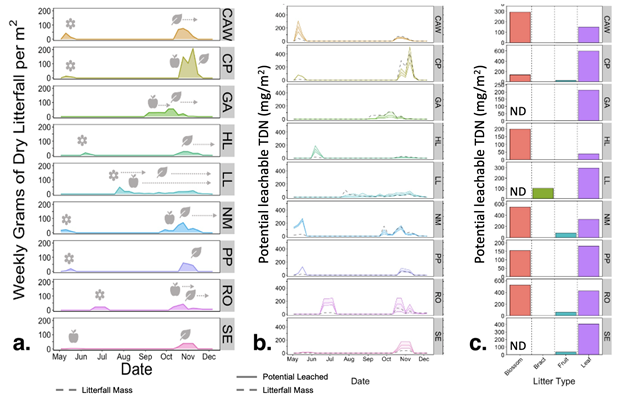|
Every spring, visitors flock to Washington, DC, to see over a thousand Japanese cherry trees in full bloom along the Potomac River. This ephemeral event draws massive numbers of viewers and concludes once the trees have shed their petals, sometimes just a week after blooming. We don’t often think about petals after they’ve fallen, but recent research suggests that these petals are more than just visually pleasing. Dr. Rebecca Hale is an urban ecologist who leads the Watershed Science Lab, a team focused on investigating urban stream dynamics to understand how cities can develop more sustainably. Dr. Hale and her team have recently found evidence that petals from flowering trees can have a tremendous impact on nutrient levels in surrounding water systems. Even in urban settings, these water systems are a foundational component of the ecosystems we rely on. Water quality is incredibly important to human health and wellbeing, yet urban water quality is often poor and unsuitable for human use. Pollution from industrial, transportation, residential, and commercial sources all contribute to significantly reduced water quality. Humans do not suffer these consequences alone; the organisms that we share our urban spaces with are also impacted by polluted urban water systems. One of the primary ways in which pollutants enter urban waterways is through stormwater runoff. How we think about managing stormwater runoff has changed significantly through time as our priorities have evolved, from simply aiming to divert large quantities of water away from cities to focusing on improving water quality, ecosystem health, aesthetics, and other factors. Using city records from Scottsdale, Arizona, Dr. Hale and her colleagues evaluated historical and contemporary approaches to stormwater management design in order to contextualize variation in urban water quality (Hale et al. 2015). They found distinct trends in design approaches corresponding with certain regions of the city. Impervious stormwater management infrastructure, such as underground pipes, was widely used during development in the 1950s. Dr. Hale found pipe drainage systems to have both increased runoff (which increases the risk of flooding events) and the highest loads of dissolved nitrogen in stormwater. In contrast, designs that help reduce the rate at which stormwater enters drainage systems, such as retention basins and natural washes, began to dominate areas developed beginning in the 1970s. These were found to have reduced runoff and lower loads of dissolved nitrogen. Just as the design of stormwater management infrastructure serves to mediate nutrient flux in urban water systems, the type and amount of tree canopy cover in a city can influence the city’s water quality by heavily impacting nutrient input into these water systems through flowers, fruits, and leaves. A doctoral student in Dr. Hale’s lab, Dr. Sophie Hill, surveyed 37,000 street-side trees in Pocatello, Idaho, to characterize the magnitude and timing of these inputs. They found that, like Scottsdale’s shifts in infrastructural trends, changes in the popularity of different tree species are visible as spatial patterns throughout the city. Green ash trees, for example, were frequently planted in the older parts of Pocatello. However, concerns about the emerald ash borer (an invasive insect pest of ash trees) have significantly decreased this tree species’ availability and desirability. Subsequently, the trend has now shifted towards little-leaf linden, which makes up a significant part of the canopy in Pocatello’s newer developments (Figure 1). Let’s return to the topic of nutrient input from trees, and in particular flower petals. It is well-known that plant tissues contain nitrogen, which leaches into water as a dissolved nutrient. In fact, many aquatic ecosystems rely on this nutrient input, but excessive amounts of dissolved nitrogen can have harmful effects (Yang & Lusk, 2018). Most inquiries into the topic focus on leaves due to the high volume of leaf tissue that trees shed each year, but leaves aren’t the only type of plant tissue that makes it to the water, and tissue quantity is not the only factor in the amount of nutrient input. In order to understand how much nitrogen leaches into water systems from various types of litterfall, Dr. Hale and her colleagues gathered petals, bracts, fruits, and leaves from nine different tree species. Estimates of the dry mass of litterfall varied by tree species, both in amount and seasonality: flower petals contributed very little to total dry mass of litterfall and bloom times for different tree species ranged across seasons. However, despite leaves constituting the bulk of litterfall dry mass, blossoms leached comparable total dissolved nitrogen into water (Figure 2). Excess nutrient deposition into urban waterways can create problems for downstream ecosystems. This topic is of particular importance to our region, as nutrient pollution from upstream sources leads to oxygen-depleted “dead zones” in places like the Chesapeake Bay. These upstream sources are for the most part agricultural, but an increasing contribution is made by stormwater runoff from urban areas.
Taking Dr. Hale’s research into consideration, one way to minimize nutrient pollution from urban stormwater may involve some creative planning in future tree planting initiatives. A major difference between leaves and blossoms is that leaves fall at a generally consistent and predictable time for all species, while blossoms may fall over a large range of time periods throughout spring and summer, depending on the species and the local environment. These findings lend more weight to the impact of tree species choice in urban areas on nutrient deposition. More accurate data regarding the timing and quantity of nitrogen deposited by trees into urban waterways can help us more effectively manage nutrient runoff. Dr. Hale now works for the Smithsonian Environmental Research Center (SERC) in Edgewater, Maryland. She plans to continue her research studying urban water systems in the Baltimore area. Works cited: Hale RL, L Turnbull, S Earl, DL Childers, NB Grimm. 2015. Stormwater infrastructure controls runoff and material export from arid urban watersheds. Ecosystems 18(1): 62-75. https://doi.org/10.1007/s10021-014-9812-2 Hill, S.K., Hale, R.L., Grinath, J.B., Folk, B.T., Nielson, R., Reinhardt, K., 2022. Looking beyond leaves: variation in nutrient leaching potential of seasonal litterfall among different species within an urban forest. Urban Ecosystems.. https://doi.org/10.1007/s11252-022-01217-8 Yang, Y.-Y., Lusk, M.G., 2018. Nutrients in Urban Stormwater Runoff: Current State of the Science and Potential Mitigation Options. Current Pollution Reports 4, 112–127. https://doi.org/10.1007/s40726-018-0087-7 Authors: Alireza Shokoohi is a M.S. student in the Lamp Lab at the University of Maryland currently studying conservation biological control using ground beetles in agricultural drainage ditch ecosystems. Eva Perry is a PhD student in the Burghardt lab at the University of Maryland, researching how environmental factors alter tree-insect interactions in urban forests. Comments are closed.
|
Categories
All
Archives
June 2024
|
Department of Entomology
University of Maryland
4112 Plant Sciences Building
College Park, MD 20742-4454
USA
Telephone: 301.405.3911
Fax: 301.314.9290
University of Maryland
4112 Plant Sciences Building
College Park, MD 20742-4454
USA
Telephone: 301.405.3911
Fax: 301.314.9290




 RSS Feed
RSS Feed




